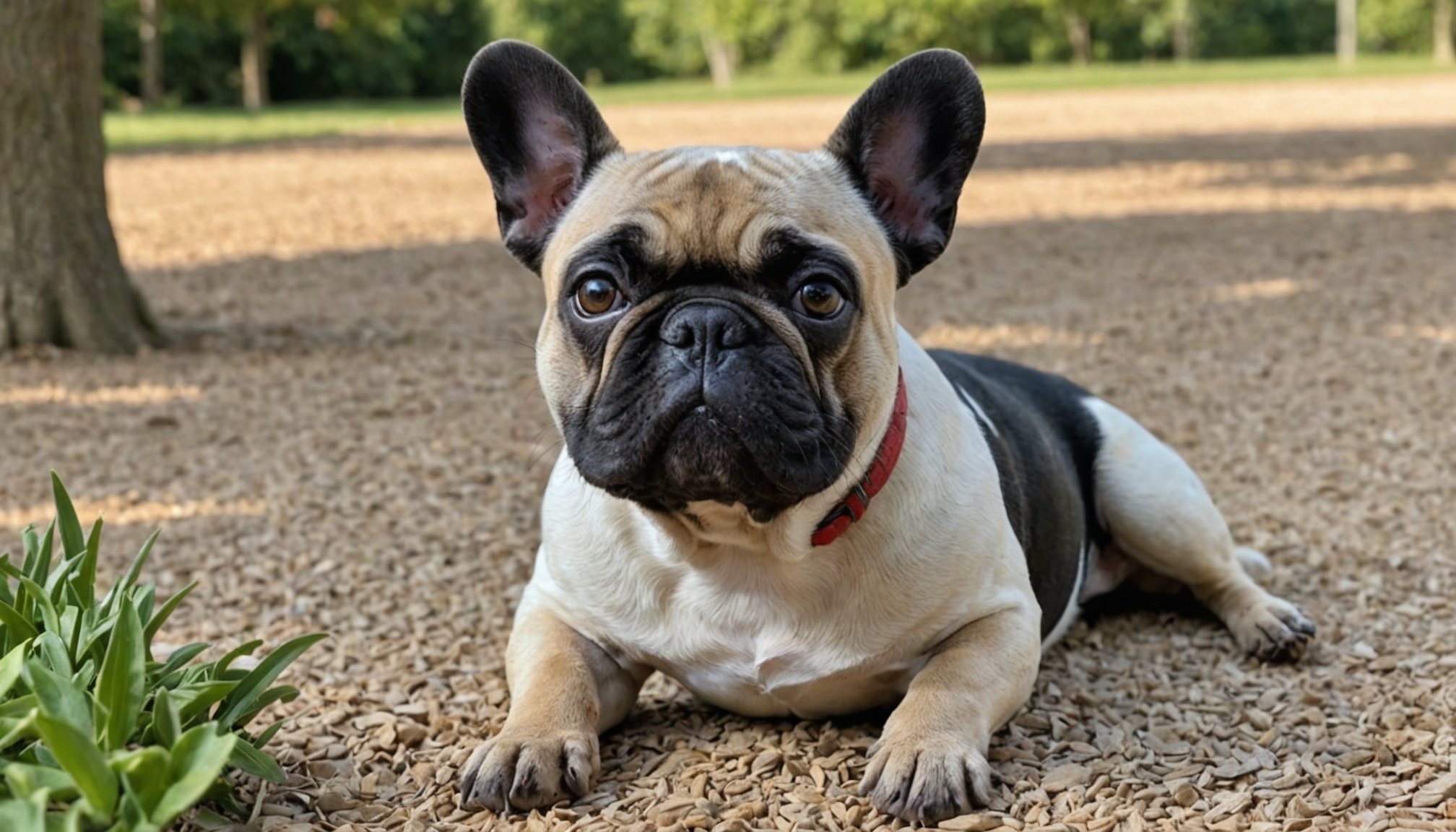Understanding Heatstroke in French Bulldogs
Heatstroke in dogs, particularly in French Bulldogs, is a serious condition that necessitates awareness and preventive action. French Bulldogs, being part of the brachycephalic breeds, are especially susceptible due to their unique anatomical features. These breeds have a shortened skull structure, which can lead to respiratory difficulties and, consequently, an increased risk of overheating.
In brachycephalic breeds, heatstroke often occurs when they are exposed to high temperatures or strenuous activity without adequate cooling periods. Their compact nasal passages impede efficient airflow, making it difficult for them to regulate body temperature through panting, their primary cooling mechanism. Excessive heat exposure without relief can quickly lead to a rise in body temperature, causing heatstroke.
A lire en complément : Top Strategies for Keeping Your Senior Pug Fit and Preventing Obesity
Recognizing vulnerable factors is crucial for French Bulldog owners. These factors include obesity, poor ventilation, and intense exercise during hot weather. Regular risk assessments for your dog can help identify situations that might trigger heatstroke. Always ensure they have access to water and shade, and avoid walking them during peak temperatures.
Understanding these physiological challenges can help dog owners make informed decisions, promoting the well-being of their French Bulldogs and preventing heatstroke effectively.
Sujet a lire : Understanding the Health Risks of Overfeeding Your Toy Fox Terrier and Effective Prevention Tips
Signs and Symptoms of Heatstroke
Identifying the symptoms of heatstroke in dogs is crucial for their well-being, especially during warmer months. Dogs can’t tell us how they feel, but they exhibit clear signs that indicate distress.
Behavioral changes are often the first indicator of dog overheating. If your dog suddenly becomes agitated, disoriented, or unusually anxious, it could signal the onset of heatstroke. Keep an eye out for frantic barking or attempts to seek shade.
Physically, there are several heatstroke indicators you should be aware of. Noticeable and excessive panting is a primary sign. Dogs may also drool excessively and show signs of lethargy. Their skin may become hot to the touch, and you might see redness around their eyes.
It’s essential to observe these signs promptly, as early detection can prevent severe outcomes. If you suspect your dog is overheating, move them to a cooler area immediately and offer small amounts of water. However, avoid using ice-cold water, as the sudden temperature change can be harmful.
Understanding these symptoms not only helps in ensuring your dog’s safety but also empowers you to act quickly, making informed decisions under stressful conditions. Always consult a veterinarian if the situation does not improve.
Environmental Factors Contributing to Heatstroke
The summer heat often brings increased environmental risks, with high-risk temperatures and elevated humidity levels posing significant dangers. Understanding weather impacts becomes crucial as temperatures soar, with humidity exacerbating the body’s ability to cool down through sweat evaporation.
When facing extreme summer heat, adopting safe outdoor practices is essential. It’s recommended to avoid outdoor activity during peak heat hours, generally from 10 a.m. to 4 p.m., when the sun’s intensity is at its highest. If outside activities are unavoidable, seek shaded areas frequently to minimize direct exposure to the harsh sunrays.
Proper hydration plays a pivotal role in maintaining body temperature. Consuming water regularly, even when not feeling thirsty, helps replenish essential fluids lost through sweating. It’s advisable to carry a water bottle to encourage frequent sips, preventing dehydration which can lead to heat-related illnesses.
Additionally, wearing light, loose-fitting, and breathable clothing can enhance comfort and safety during high temperatures. Such attire facilitates better airflow around the body, further assisting in temperature regulation. Implementing these measures significantly reduces the risk of succumbing to heatstroke, ensuring a safer and more enjoyable experience during the hot summer months.
Prevention Strategies for Heatstroke
When preventing heatstroke in dogs, especially breeds like French Bulldogs, a combination of care tips and dog safety strategies is essential for their well-being.
Hydration Techniques
First and foremost, ensure your dog has regular access to water. This might seem simple but is a crucial step in preventing heatstroke. To encourage your pet to drink more water, consider creative approaches such as offering ice cubes or diluted broths. There are also cooling products designed to maintain their fluid intake. Using these techniques consistently can significantly help regulate your dog’s body temperature.
Ideal Exercise Routines
The best times for exercise during warmer months are early morning or late evening when temperatures are cooler. Opt for low-impact activities such as short, shaded walks or indoor play sessions. These are easier on your dog while being stimulating. Engaging in mental stimulation like puzzle toys provides benefits without exposing your dog to excessive heat.
Cooling Aids and Techniques
Explore the use of cooling aids like mats, vests, and fans. They provide significant relief and are a practical choice for hot days. Natural cooling methods, such as using water and shade effectively, can also keep your dog comfortable. Look out for signs of comfort, like a relaxed demeanor, to ensure these aids are effective in managing their body temperature.
First Aid for Heatstroke
When encountering a heatstroke emergency in dogs, swift and effective first aid is crucial. Initially, remove the dog from the hot environment and move them to a cooler, shaded area. Begin cooling efforts by applying tepid water to the dog’s body, focusing on areas with less fur, such as the belly and underarms. Do not use ice-cold water, as rapid cooling can be harmful. Ensure the dog has access to cool, fresh water to drink, but do not force them to drink.
Contacting a veterinarian immediately should be the next step after initial first aid measures. The veterinarian can provide professional advice and determine if further emergency response is necessary. Veterinary guidance is crucial, as severe heatstroke can lead to complications such as organ damage without proper care.
Long-term care post-heatstroke focuses on monitoring for any residual health issues. Pay attention to symptoms such as lethargy or decreased appetite, which may indicate lingering effects. In consultation with a veterinarian, develop a recovery plan that includes regular check-ups and possibly adjusting exercise routines or environments during hot weather to prevent recurrence. Through timely emergency response and diligent aftercare, a dog’s resilience can be supported and their health safeguarded.
Expert Opinions and Case Studies
Understanding the challenges faced by French Bulldogs in hot weather is essential. Veterinary advice plays a crucial role in heatstroke prevention. Dr. Emily Harris, a prominent veterinarian, emphasizes the importance of recognizing early signs, stating: “Vigilance in observing symptoms such as excessive panting and drooling can be lifesaving.” Her insights reaffirm that immediate action is vital.
Real-life case studies further highlight these challenges. One poignant example details a French Bulldog named Max, who narrowly survived a heatstroke incident. His owners initially mistook his fatigue for lethargy from play but, guided by their vet’s advice, they quickly sought medical attention. This precautionary step was crucial in Max’s recovery.
Interviews with experienced pet owners reveal their best practices. Sarah, a seasoned Bulldog owner, shares: “We always carry a portable water bowl and keep outdoor activities brief during peak sun hours. Our vet advised creating shaded rest areas in our garden to keep Duke cool.”
Combining expert insights with documented cases provides a comprehensive understanding of heatstroke prevention. Veterinarians and experienced owners advocate for proactive measures, ensuring the well-being of these sensitive breeds. Through collaboration and shared experiences, the French Bulldog community can continue to navigate heat-related risks effectively.
Visual Aids and Resources
The use of infographics can significantly enhance understanding of heatstroke, showcasing both symptoms and prevention methods clearly. A well-designed infographic may illustrate symptoms like excessive sweating and dizziness, alongside prevention strategies such as staying hydrated and avoiding excessive heat exposure.
Educational materials serve as valuable heatstroke resources, empowering individuals and communities to identify warning signs early and act promptly. Comprehensive resources often include step-by-step guides and illustrations that detail emergency responses and preventive measures.
Community awareness is crucial for effectively combating heatstroke. By distributing educational materials widely, communities can foster an environment of vigilance and mutual support. Encouragingly, many organizations offer accessible resources for public dissemination.
For those seeking further assistance and education, various recommended resource links provide additional insights into managing and preventing heatstroke. These links offer in-depth explanations and updates on best practices, equipping readers with the latest knowledge.
Understanding heatstroke and its dangers is not just a personal responsibility, but a community duty. Distributing engaging infographics and utilizing diverse educational materials can help ensure that every community member is informed and prepared, fostering a safer environment for all.
Conclusion and Additional Support
Navigating the world of pet ownership involves various aspects that can be daunting. Thankfully, there are ample dog owner support networks and community resources that can provide assistance. Local pet clubs often host meetings where dog owners can share experiences and advice. Online forums and social media groups also offer vibrant communities eager to help with tips and guidance.
Further learning is another valuable component of responsible pet ownership. Many libraries and bookstores feature sections dedicated to pet care, offering books that cover everything from basic first aid to advanced training techniques. Taking the initiative to enrol in courses or workshops offered by animal welfare organisations can enrich your knowledge and strengthen your bond with your furry friend.
It’s important to foster proactive discussions about pet health and safety. Engaging with veterinarians or joining seminars on modern nutrition and pet safety can equip dog owners with the tools necessary for maintaining a pet’s wellbeing. Active participation in these avenues not only benefits the individual dog owner but also contributes to the collective knowledge and support of the community.
Every step taken towards becoming a more informed and supportive community member creates a healthier environment for dogs everywhere.
Understanding Heatstroke in French Bulldogs
Heatstroke is a serious condition that poses a significant threat to brachycephalic breeds, such as French Bulldogs. These breeds have a shortened snout, which compromises their ability to cool down effectively, making them prone to overheating. French Bulldogs, in particular, are susceptible because their unique anatomy restricts airflow.
When it comes to symptoms, French Bulldogs often exhibit signs like excessive panting, difficulty breathing, and drooling. In severe cases, they may become lethargic, display vomiting, or even collapse due to their inability to regulate body temperature effectively. Being aware of these symptoms is crucial for owners.
Timely intervention is paramount for at-risk breeds to prevent severe complications. Immediate actions, such as moving the French Bulldog to a cooler environment or applying damp towels to their body, can mitigate the effects of heatstroke. Water should be provided, but it must be done gradually to avoid shock.
Brachycephalic breeds require particular care during hot weather or high-stress situations due to these vulnerabilities. Owners should be proactive, monitoring environmental temperatures and limiting strenuous activities. This vigilant approach greatly reduces the risk of heat-related illnesses, ensuring that French Bulldogs remain healthy and safe.
Recognizing Symptoms of Heatstroke
A French Bulldog may be prone to heatstroke symptoms owing to their brachycephalic nature. Recognising the signs of overheating is pivotal for their wellbeing. Common indications of heat exhaustion in this breed often manifest through behavioural changes. These include excessive panting and difficulty breathing, which are more intense than during regular exercise.
Physical symptoms can be quite telling. Notably, a bright red or pale tongue and gums, drooling, and an elevated heart rate are crucial signals. Visual cues such as lethargy, disorientation, or even vomiting may further highlight heat-related distress in French Bulldogs.
Distinguishing between normal fatigue and heatstroke symptoms is essential. Unlike regular tiredness, where the dog merely requires rest and hydration, overheating can rapidly escalate to a dangerous condition. For instance, if your French Bulldog is collapsing or unresponsive, this goes beyond normal fatigue and warrants immediate intervention.
Preemptive observation and awareness are key in protecting your French Bulldog from heat-related hazards. By understanding these symptoms and acting swiftly, one ensures the dog’s safety and prevents the severe consequences of unchecked heat exposure.
Effective Cooling Techniques
Overheating in dogs can be a serious concern, requiring prompt attention with effective cooling methods. Immediate solutions include using cool, damp towels or directing fans at them for temperature control. These methods help bring down their core temperature quickly.
Encouraging Hydration and Water Intake
Hydration plays a crucial role in keeping dogs cool. Ensure there are always multiple water bowls available. To encourage water intake, try adding ice cubes to their water or offering dog-friendly hydrating treats, like watermelon chunks. You can also experiment with flavored broths diluted with water, as some dogs may find them more appealing than plain water.
Long-term Cooling Solutions
For long-term temperature control at home, consider investing in cooling mats or setting up a cool, shaded area in your garden. Fans and air conditioning are also beneficial, but remember, their placement is important to ensure evenly distributed cool air. Reflective shades and window films can also keep indoor temperatures down by blocking excess sunlight.
Implementing these comprehensive strategies ensures your pet’s environment stays comfortable and their hydration levels remain optimal. Addressing these aspects will help keep your dog safe and healthy during hot weather.
Seasonal Precautions for French Bulldogs
French Bulldogs, known for their charming nature, require seasonal care to keep them safe and healthy. Summer can pose serious challenges due to their brachycephalic anatomy, making weather safety essential.
During high-temperature months, schedule outdoor activities for cooler times, like early morning or late afternoon. Intense heat can be dangerous due to their shorter snouts, which hinder efficient cooling. Always provide plenty of water and seek shade frequently.
To ensure a comfortable and safe environment at home, practice best methods for cooling your space. Consider using fans or air conditioning and ensure your French Bulldog has access to well-ventilated areas. A cooling mat can also help maintain an optimal temperature indoors.
Adjusting exercise routines is vital in warmer months. Engage in less intense activities and monitor your dog for signs of overheating, such as excessive panting or drooling. Activities like short, shaded walks can be beneficial, and indoor play can offer both mental and physical stimulation without exposing them to extreme temperatures.
By adhering to these summer tips, you can safeguard the health of your French Bulldog, allowing a happy and enjoyable season for both you and your canine companion.
Specific Care Guidelines for Brachycephalic Breeds
Brachycephalic breeds, known for their charming features and distinctively short noses, require specialised care. French Bulldogs, in particular, encounter unique challenges, especially in hot weather. Due to their anatomy, French Bulldog health can be affected by overheating, as they struggle to regulate temperature efficiently. It is crucial for owners to ensure their French Bulldog remains cool and hydrated, employing strategies such as keeping them in shaded areas or air-conditioned rooms.
Furthermore, regular vet check-ups are vital for maintaining the well-being of brachycephalic breeds. Routine visits can help monitor potential health issues such as breathing difficulties. Engaging in preventive care ensures any arising complications are addressed early, promoting long-term health.
For effective brachycephalic care, consider investing in recommended products and gear specifically catered to these breeds. Look into items like harnesses rather than collars, which reduce the risk of respiratory distress. Additionally, cooling mats and portable fans provide immediate relief in hotter temperatures.
Incorporating these breed-specific tips into their routine can significantly enhance a French Bulldog’s quality of life. By understanding and responding to their special needs, owners can ensure their beloved pets remain happy and healthy year-round.
Expert Recommendations and Resources
Seeking expert advice when it comes to your pet’s well-being is crucial, especially during warmer months. Veterinarians emphasize treating heat exposure in dogs with vigilance and care. Vet recommendations highlight ensuring ample hydration and minimizing time spent in hot environments. Furthermore, it is suggested that dog owners observe their pets for signs of heat stress, such as excessive panting or lethargy.
Dog care organizations offer recommended guidelines to help manage heat exposure. These often include practical steps like scheduling walks during cooler parts of the day and providing shaded rest areas.
To support these efforts, a variety of resources are available to dog owners. For example, checklists can assist in preparing for trips during hot weather, and infographics visually demonstrate heat safety tips. These can be found in pamphlets at local veterinary clinics or through dedicated online portals from reputable pet care organisations.
By leveraging these resources and following expert advice, you empower yourself to make informed decisions about your pet’s health and safety. For detailed vet recommendations tailored to your dog’s specific needs, it’s always beneficial to consult directly with your veterinarian. This ensures the most accurate and personalized care.
Personal Anecdotes and Case Studies
In the world of dog owner experiences, shared stories often highlight how others have successfully managed heatstroke in their French Bulldogs. For example, one owner discussed how a simple intervention—like using a cooling vest—helped bring their pet’s temperature down during a heatwave. Such personal stories not only offer guidance but also hope for those facing similar challenges.
Case studies further illuminate the complexities and solutions involved. One study examined multiple dog owner experiences where preventive measures—like avoiding walks during peak heat—played a critical role in preventing heat-related emergencies. These personal accounts can sometimes be eye-opening, revealing overlooked risks in daily routines.
Lessons learned from unfortunate incidents are also significant. Several owners recounted close calls with heatstroke due to a lack of awareness. These candid admissions serve as cautionary tales for the broader community, reinforcing the importance of vigilance and preparedness.
Community engagement among French Bulldog owners has proven invaluable. Online forums and local meet-ups often provide platforms for sharing personal stories and case studies, allowing for collective learning. This engagement fosters a supportive network where owners can learn from others’ experiences and even implement tried-and-tested strategies to keep their beloved pets safe.
Visual Aids and Checklists
To ensure the well-being of your French Bulldog during outdoor activities, having visual aids and checklists is crucial.
Infographics can play an essential role in providing easy-to-follow guides for recognizing the symptoms of heatstroke, which is vital given the breed’s sensitivity to heat. An effective infographic might include visual cues like panting intensity, drooling, and lethargy, helping owners quickly identify these signs.
Checklists are another valuable tool when planning safe outdoor adventures. A comprehensive checklist could remind owners to bring essentials like water, a portable fan, and a cooling vest. It also ensures that the duration and timing of outdoor activities are suitable, especially during hotter months.
For cooling methods and spotting signs of distress, a set of visual reminders can be lifesaving. These might include images or icons illustrating cooling techniques such as using damp towels, applying pet-safe cooling gels, or positioning dogs in shaded areas.
Integrating these visual aids into your routine simplifies remembering crucial actions and ensures your French Bulldog stays safe and comfortable. By utilizing infographics and checklists, it becomes easier to uphold your pet’s safety without overlooking essential steps.











